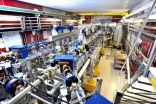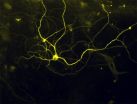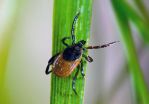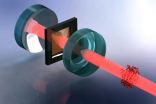(Press-News.org) The structure of pores found in cell nuclei has been uncovered by a UCL-led team of scientists, revealing how they selectively block certain molecules from entering, protecting genetic material and normal cell functions. The discovery could lead to the development of new drugs against viruses that target the cell nucleus and new ways of delivering gene therapies, say the scientists behind the study.
At the heart of every cell in our body is a cell nucleus, a dense structure that contains our DNA. For a cell to function normally, it needs to surround its nucleus with a protective membrane but this must open enough to let vital molecules in and out, so the membrane is pierced by hundreds of tiny gateways known as nuclear pores.
The research, published today in Nature Nanotechnology, reports on nuclear pores in frog eggs and reveals how these pores can act like a supercharged sieve, filtering molecules by size but also based on chemical properties. Co-lead author Dr Bart Hoogenboom, from the London Centre for Nanotechnology (UCL Mathematics & Physical Sciences), said: "The pores have been known to act like a sieve that could hold back sugar while letting grains of rice fall through at the same time, but it was not clear how they were able to do this."
Dr Ariberto Fassati, co-lead author from the Wohl Virion Centre (UCL Infection & Immunity), added: "We found that the proteins in the centre of the pores tangle together just tightly enough to form a barrier, but not too tightly - like a clump of spaghetti. Remarkably, the strands of 'spaghetti' cluster together in a precise way which allows small molecules and salts to flow through without any trouble. Larger molecules, like messenger RNA, can only pass when accompanied by chaperone molecules. These chaperones, called nuclear transport receptors, have the property of lubricating the strands and relaxing the barrier, letting the larger molecules through. This can happen up to several thousand times per second."
Before now, scientists understood the overall shape of the pores and that protein structures in the middle of them controlled the flow of molecules, but it was not known how they did this. Some theories suggested the pores acted like a brush and others like a sieve. The researchers behind this study say it was hard to determine which was correct because of the small and fragile nature of the pores and the difficulties in locating the proteins in the pores.
The team used a technique known as atomic force microscopy (AFM) to study the pores. Much like people can use their fingers to read braille, feeling the words rather than seeing them, atomic force microscopes move a minuscule needle across the surface of a sample, measuring its shape and hardness. This method was chosen over other techniques because the pores are too small for optical microscopy and too flexible and mobile for X-ray crystallography.
"AFM can reveal far smaller structures than optical microscopes," Dr Hoogenboom explained, "but it's feeling rather than seeing. The trick is to press hard enough to feel the shape and the hardness of the sample, but not so hard that you break it. It's a slow and painstaking process, but it allows us to come up with far better maps of small objects than is possible with other methods - even individual atoms can be observed this way. We used it to successfully probe the membrane that had been peeled away from the nucleus of the frog eggs, to reveal the structure of the pores."
As well as explaining the remarkable properties of nuclear pores, and the role they play in higher life forms, the research may also hold promise for the development of new antiviral drugs and better delivery mechanisms for gene therapy.
Dr Fassati said: "Certain viruses are able to enter the cell nucleus by tricking the proteins at the centre of nuclear pores into letting them in. Now that nuclear pores are better understood, there may be opportunities to develop drugs that prevent viruses entering in this way. It may also be possible to improve on the design of current mechanisms for delivering gene therapy to better cross the nuclear pores and deliver their therapeutic genes into the nucleus."
INFORMATION:
The team included researchers from across UCL, alongside collaborators at Birkbeck, University of London and the University of Münster, Germany.
The first detailed, high-resolution 3-D maps of Antarctic sea ice have been developed using an underwater robot. Scientists from the UK, USA and Australia say the new technology provides accurate ice thickness measurements from areas that were previously too difficult to access.
The results, published this week in the journal Nature Geoscience (Monday 24 November 2014), step up the pace of research in the polar regions aimed at understanding the dramatic sea ice changes in the context of climate change.
Scientists use a range of technologies and techniques to measure ...
Scientists have discovered a gene that protects people against one of the major causes of stroke in young and middle-aged adults and could hold the key to new treatments.
Researchers from Royal Holloway, University of London, together with an international team from across the United States and Europe, have found that people with a specific variant of a gene, known as PHACTR1, are at reduced risk of suffering cervical artery dissection, which is caused by a tear in an artery that leads to the brain.
The new discovery, published in the journal Nature Genetics, could ...
Scientists at the Helmholtz-Zentrum Dresden-Rossendorf (HZDR) have studied the dynamics of electrons from the "wonder material" graphene in a magnetic field for the first time. This led to the discovery of a seemingly paradoxical phenomenon in the material. Its understanding could make a new type of laser possible in the future. Together with researchers from Berlin, France, the Czech Republic and the United States, the scientists precisely described their observations in a model and have now published their findings in the scientific journal Nature Physics.
Graphene ...
Boston, MA - Researchers at Harvard School of Public Health (HSPH) have found a novel mechanism causing type 2 diabetes that could be targeted to prevent or treat the disease. The research highlights a previously unrecognized molecular pathway that contributes to the malfunction of liver cells in obesity, leading to insulin resistance and diabetes.
The study appears online November 24, 2014 in Nature Medicine.
"While it is well-established that obesity generates cellular and molecular stress leading to abnormal functioning of many cellular processes, the mechanisms ...
CAMBRIDGE, MA -- Researchers have made great progress in recent years in the design and creation of biological circuits -- systems that, like electronic circuits, can take a number of different inputs and deliver a particular kind of output. But while individual components of such biological circuits can have precise and predictable responses, those outcomes become less predictable as more such elements are combined.
A team of researchers at MIT has now come up with a way of greatly reducing that unpredictability, introducing a device that could ultimately allow such ...
After more than six years of intensive effort, and repeated failures that made the quest at times seem futile, Harvard Stem Cell Institute (HSCI) researchers at Boston Children's Hospital (BCH) and Harvard's Department of Stem Cell and Regenerative Biology (HSCRB) have successfully converted mouse and human skin cells into pain sensing neurons that respond to a number of stimuli that cause acute and inflammatory pain.
This "disease in a dish" model of pain reception may advance the understanding of different types of pain, identify why individuals differ in their pain ...
Cloaking immune cells with antibodies that block T cell trafficking to the gut can substantially reduce the risk of viral transmission in a non-human primate model of HIV infection, scientists report.
The findings suggest that drugs that are already in clinical trials for inflammatory bowel diseases might be effective in the treatment or prevention of HIV infection.
The results are scheduled for publication in Nature Medicine.
"We were surprised by the effects that we observed," says senior author Aftab Ansari, PhD, professor of pathology and laboratory ...
It's a dog eat dog world, and bacteria have been living in it for a long time. It's of no surprise that bacteria have a sophisticated arsenal to compete with each other for valuable resources in the environment. In 2010, work led by University of Washington Department of Microbiology Associate Professor Joseph Mougous uncovered a weaponry system used in this warfare between bacteria. The combatants inject deadly toxins into rival cells.
Now, in a surprising twist, Mougous and colleagues have found that many animals have taken a page from the bacterial playbook. They steal ...
EAST LANSING, Mich. --- What will it take to convince skeptics of global warming that the phenomenon is real? Surely, many scientists believe, enough droughts, floods and heat waves will begin to change minds.
But a new study led by a Michigan State University scholar throws cold water on that theory.
Only 35 percent of U.S. citizens believe global warming was the main cause of the abnormally high temperatures during the winter of 2012, Aaron M. McCright and colleagues report in a paper published online today in the journal Nature Climate Change.
"Many people already ...
Physicists at the University of Basel have developed a new cooling technique for mechanical quantum systems. Using an ultracold atomic gas, the vibrations of a membrane were cooled down to less than 1 degree above absolute zero. This technique may enable novel studies of quantum physics and precision measurement devices, as the researchers report in the journal Nature Nanotechnology.
Ultracold atomic gases are among the coldest objects in existence. Laser beams can be used to trap atoms inside a vacuum chamber and slow down their motion to a crawl, reaching temperatures ...






